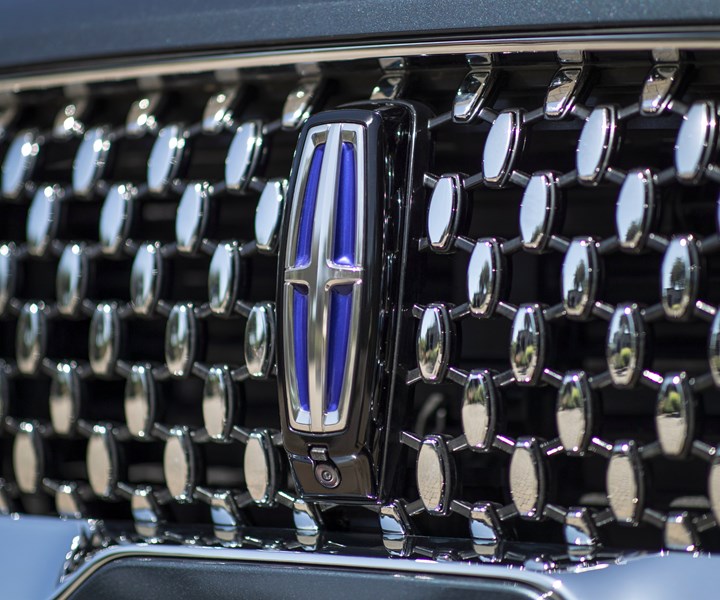The 2020 Lincoln Aviator is Engineered for Quiet Flight
Where poetry meets engineering. Really.
#electronics #aluminum #interior

(Images: Lincoln)
When the Lincoln Aviator was officially unveiled at the 2018 LA Auto Show, then-Lincoln Design Director David Woodhouse used words including beauty, effortless, human, gliding, sanctuary, flight. Which, (1) sounds really good in a British accent, as he has, and (2) are the sorts of words that you’d expect to hear from a designer.
So it is all the more surprising to hear, at the official launch driver program in the summer of 2019, John Davis, global chief program engineer for the 2020 Lincoln Aviator, a man who has a mechanical engineering bachelor’s degree from the University of Illinois at Urbana-Champaign and a graduate degree in engineering management from Wayne State University in Detroit, a man whose previous job before getting the Lincoln position in the spring of 2015 was as chief program engineer — Ford Commercial Vehicles, which meant he engineered vehicles including the F-650/F-750 medium-duty trucks, say, “This is the product where it all comes together — beauty, human, gliding, sanctuary.”
He is an engineer. Not a designer. Yet when he says “Quiet Flight” it isn’t as though he is hewing to the marketing message for the three-row crossover that’s sitting on a new RWD platform: he explains it with engineering-driven information.
For example, consider the quiet.
Addressing Noise, Vibration, and Harshness (NVH)
Davis points out that there is an array of noise-vibration-harshness countermeasures executed in the Aviator, both passive and active systems. For example, there is the use of laminated glass on the windshield as well as for the front and rear doors. For the vehicles that have the 21- or 22-inch wheel and tire package there is a layer of foam inside the tire cavity. “When you have larger wheels but smaller profile tires, it can get very noisy, so we try to minimize that,” Davis says. There is active noise control. And on the Black Label trim level of the Aviator there is a three-stage vacuum-driven engine mount to minimize the vibrations from the powertrain—and while those vibrations may not be sound waves, per se, it is all about achieving the experience that minimizes distraction.

The 2020 Lincoln Aviator is based on a RWD platform, though it is available as AWD. It comes standard with a 400-hp twin-turbo 3.0-liter V6 or as a plug-in hybrid that uses the same engine and supplements it with an electric drive motor to provide 494 systems horsepower.
Providing Power
“We thought that one of our tenets of delivering on the ‘Quiet Flight’ experience are the aspects of gliding and effortless performance,” Davis says, and then launches into a description of the powertrain.
There are two powertrains available for the Aviator. The standard model comes with a twin-turbocharged 3.0-liter V6 engine with start-stop technology. It produces 400 hp and 415 lb-ft of torque. The engine is mated to a 10-s
The standard twin-turbocharged 3.0-liter V6 engine, paired with a new 10-speed SelectShift automatic transmission.
The same engine is used for the Grand Touring version of the Aviator, which is a plug-in hybrid. In this case, thanks to the use of a 75-kW electric motor that is integrated with the 10-speed transmission (the transmission was specifically designed to be able to accommodate an electric motor), the total horsepower of that vehicle is 494 and it produces 630 lb-ft of torque. “This was not about building a track vehicle, but to provide an effortless performance experience,” Davis says.
The Electrified Approach
He also points out that in order to achieve that kind of performance some competitors in this space have opted for a larger-displacement V8, “but we thought it was smarter to go with an electrified powertrain.”

The Grand Touring Aviator is a plug-in hybrid. The system performance is 494 hp @ 5,500 rpm and 630 lb-ft of torque @ 2,250 rpm. With a Level 2 charger (240 volts) a full charge is obtained in four hours or fewer. The Aviator can travel approximately 18 miles on electricity alone.
There is a 13.6-kWh battery pack that provides approximately 18 miles of electric-only range for the vehicle; Davis points out that they didn’t engineer the Grand Touring to be a fuel-economy focused vehicle, but that the setup provides the sort of performance that gives the Aviator the aforementioned “effortlessness.” He notes that not only do the twin turbos of the internal combustion engine provide solid torque at low RPMs but that the electric motor provides over 200 lb-ft of torque starting from 0 RPM.
(It is worth noting that Davis also worked on the Ford C-MAX Hybrid and C-MAX Energi, so he knows more than a little something about electrified vehicles.)
Smooth Suspension
Another aspect of “gliding” is the setup of the suspension. There is Adaptive Suspension, which uses a set of 12 sensors that are checking various vehicular conditions (e.g., vehicle motion, body movement, steering angle, acceleration) that result in the ability to “read” the road 500 times per second and then to make adjustments to the suspension setup as many as 100 times per second.
One interesting capability of this is what Davis calls “advanced pothole mitigation.” Based on whether a wheel is dropping more than what might typically be the case, meaning that it may be going into a pothole, the system stiffens the shock absorber, thereby reducing the amount of drop. “We try to increase the damping rate very quickly to keep the wheel and tire from falling all the way down into a pothole,” Davis says, adding, “It may mitigate the damage to the wheel and tire.”
(It is worth noting that Davis lives in Michigan, and in 2018 Gretchen Whitmer was elected governor of the state, predicated largely on her slogan “Fix the damn roads”; as a resident of the state, he knows more than a little something about potholes, too.)

The interior of the Aviator is supposed to be “sanctuary”-like. It is. Yet unlike what you may imagine of a sanctuary, it is full of available tech, ranging from a 30-position seat to a 28-speaker Revel Ultima 3D audio system.
There is another stage of that suspension is Adaptive Suspension with Road Preview. In this arrangement, a forward-facing camera scans the road 50 feet ahead looking for height deviations on the surface measuring from two to eight inches. Based on the detected vertical changes, Davis says, “We can anticipate them and perfectly setup the suspension before we get there.”
Then the smoothest glide of all is the availability of Air Glide Suspension, which replaces the coil springs with air springs. There are independent air bladders for each wheel. This allows more precise adjustment of the spring rates. Another thing that this allows is to lower the height of the vehicle when the driver is approaching it from the outside so as to make ingress easier.
Measures & Mass
Speaking of the dimensions of the vehicle, Davis says, “We call the Aviator big, but not bulky.” The crossover is 199.3 inches long, 69.6 inches high, 82.3 inches wide (with mirrors folded), and has a 119.1-inch wheelbase. Davis says that one of the areas where particular attention was paid is in the cabin, making sure that there is sufficient storage for those who are looking for utility in a crossover. He points out that many three-row vehicles have a small amount of cargo capacity behind the third row; the Aviator has 18.3 cubic feet. Overall, behind the first row there is a maximum cargo volume of 77.7 cubic feet. As regards passenger volume, there are 140.5 cubic feet with the Vista roof and 144.7 cubic feet without that panoramic roof.

While the cargo capability of some hybrids is truncated by the location of the battery pack, that’s not an issue with the Grand Touring Aviator, as the 96-pouch-style lithium-ion battery pack is located between the floor of the second row and doesn’t minimize passenger or cargo space.
But for all of its size, Davis says they paid attention to mass and deployed an approach that he describes as “a smart execution of mixed materials.” The hood is aluminum but the remainder of the closures are steel. The body structure consists of a variety of steel grades, ranging from high-strength hot-stamped steels to mild steels. Many of the suspension components are aluminum. The curb weight of a standard rear-wheel drive Aviator is 4,774 pounds; it is 4,892 pounds for the AWD version. The Grand Touring AWD Aviator comes in at 5,673 pounds. “It is about managing weight efficiently and smartly,” Davis says.
One of the goals for the 2020 Lincoln Aviator, whether the standard or the plug-in hybrid version, was, Davis says, to have “at least 400 miles of total range.”
Why? Because that contributes to effortlessness, he says, “It is a capable vehicle not encumbered by range.”
Indeed.
RELATED CONTENT
-
The Genovation GXE: >220 mph and Street Legal
A 2019 Corvette Grand Sport has a starting price on the order of $66,950. The Genovation GXE, which is predicated on the Corvette Grand Sport, will set you back some $750,000.
-
Mustang Changes for 2018
On Tuesday Ford unveiled—using the social media channels of actor Dwayne Johnson (this has got to unnerve some of the auto buff book editors)—the 2018 Mustang, which has undergone some modifications: under the hood (the 3.7-liter V6 is giving way to a 2.3-liter EcoBoost four, and a 10-speed automatic is available), on the dash (a 12-inch, all-digital LCD screen is available for the dashboard), at the tires (12 wheel choices), on the chassis (MagneRide damper technology is being offered with the Mustang Performance Package), and on the exterior (three new paint colors). And while on the subject of the exterior, there are some notable changes—a lower, remodeled hood, repositioned hood vents, new upper and lower front grilles, LED front lights, revised LED taillamps, new rear bumper and fascia.
-
About the 2019 Toyota RAV4
Last year Buick sold 219,231 vehicles in the U.S.


.jpg;width=70;height=70;mode=crop)